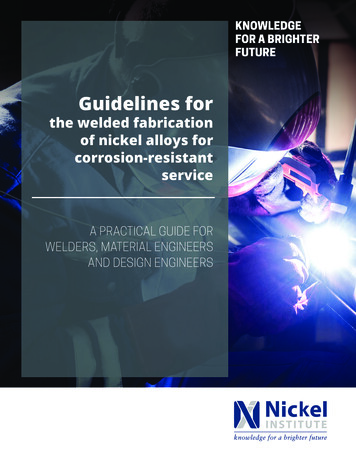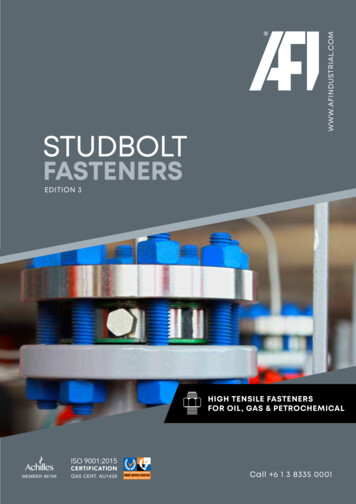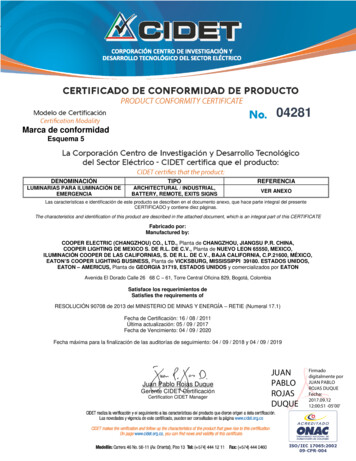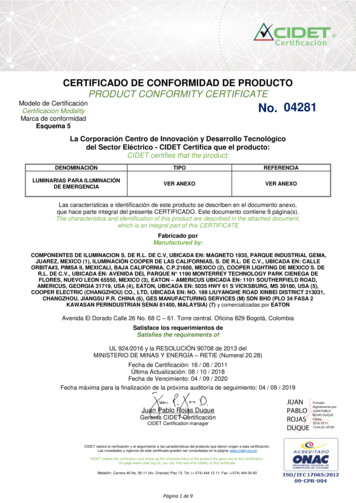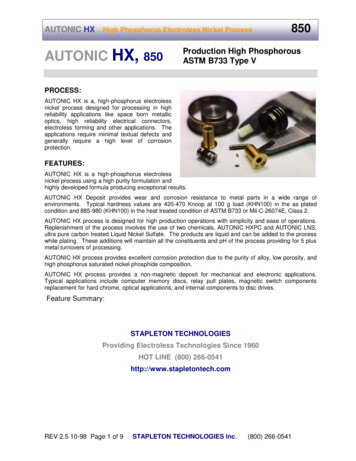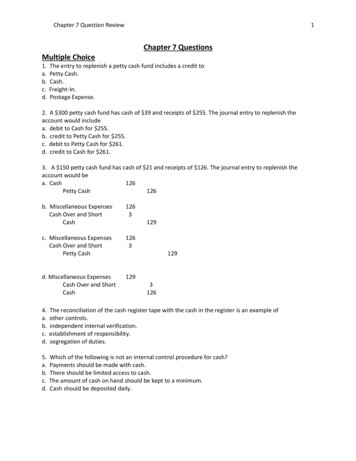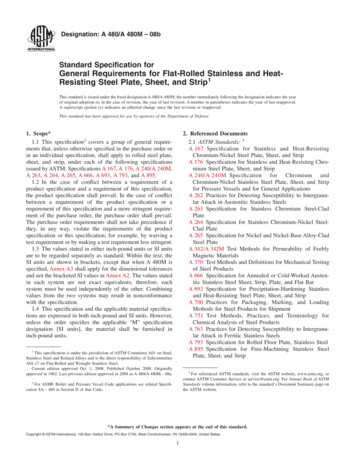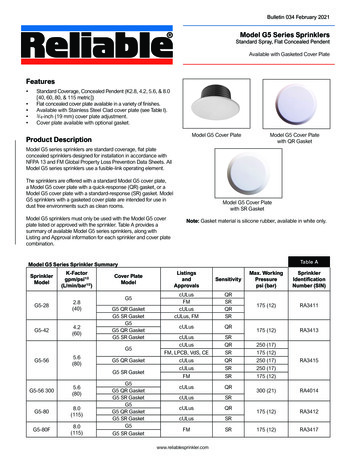
Transcription
Nickel Deposits ofNorth AmericaBy H. R. CORNWALLGEOLOGICALSURVEYBULLETIN1223Geology, resources, and reserves ofnickel sulfide and nickeliferouslaterite deposits in 7 Provinces ofCanada and 15 States of theUnited StatesUNITED STATES GOVERNMENT PRINTING OFFICE, WASHINGTON : 1966
UNITED STATES DEPARTMENT OF THE INTERIORSTEWART L. UDALL, SecretaryGEOLOGICAL SURVEYWilliam T. Pecora, Directorl!'irst printing 1966Second printing 1967For sale by the Superintendent of Documents, U.S. Government Printint OfficeWashintton, D.C. 20402- Price 25 cents (paper cover)
---------------------------Introduction --.- ---Types of deposits ----112Sulfide Nickeliferous laterite deposits -----------------------Nickel minerals ----- ---------Native nickel-iron ---------------PenUandueBravoite and violarite -------7778888889991516 ----HeazlewooditeLinnaeite, polydymite, siegenite, and violariteOther minerals ------Nickel arsenide, sulfarsenide, antimonide, and other mineralsHydrated nickel arsenate, sulfate, and carbonateGarnierite .Nickel resourcesNickel deposits of CanadaBritish Columbia ---- --------- ----------Lynn Lake ompson- oak Lake district ---------------------------St. ---Northwest Territories ---- ----------Rankin Inlet ------- --------------Alexo Nickel mine - Kenora district ----- -------Limerick township --------- ---------------------------Raglan township -------- -------------------------Sudbury district ------ ----------------------------------Belleterre ----- --La otte township ------------------------------------U nga va district - - 3333434
IVCONTENTSNickel deposits of --------------------------Canala.sk (White River)-----------------------------------Quill Creek (Kluane Lake)---------------------------------Nickel deposits of the United hemia Basin, 1rakobi IslandBrady Glacier ----- ----Funter Bay, Admiralty IslandMirror Harbor, Fleming Island-----------------------------Snipe Bay, Baranof Island---------------------------------Spirit Mountain, Copper River --------------Saline ----------------------------------------Boulder --------------------------------------------JGnox ----Bunkerville districtCottonlVood ini depositNorth --------------Oregon and -Nickeliferous lateritesNickel Mountain p Nickel mine BlelVett deposit ----------------------------·-Referencescited 5565758
CONTENTSvILLUSTRATIONPageFIGURE1. Nickel deposits of North America11TABLESTABLE 1.2.3.4.5.6.7.8.Nickel minerals ------------------- -------- ----Nickel deposits of North AmericaTotal nickel resources of North AmericaNickel reserves of North AmericaMarginal and submarginal nickel resources of North AmericaNickel-copper reserves of Lynn Lake, 195LOre reserves in the Sudbury districtNickel-iron resources at Cle Elum, Wash510101213183335
NICKEL DEPOSITS OF NORTH: AMERICABy H. R.CoRNWALLABSTRACTNickel is estimated to be the fifth most abundant element of the earth, havingan average bulk percentage of 2.7. The average nickel content of the earth'scrust, however, is estimated to be only 0.008 percent. The minimum concentration of nickel in deposits that can be economically mined is about 1.2 percent, or150 times the content of the crustal rocks in which the deposits occur.There are two principal types of nickel deposits : ( 1) sulfide deposits consisting mainly of pyrrhotite and pentlandite, with or without accompanyingchalcopyrite, and closely associated with norite and peridotite, and (2) nickeliferous laterite deposits, occurring as weathering mantles that overlie peridotite (the nickel silicate variety) and serpentinite (the nickeliferous ironvariety).The largest nickel sulfide deposits in the world are in Canada-in the Sudburydistrict, Ontario, and the Thompson district, Manitoba. Smaller deposits ofthis type are scattered throughout Canada and the United States. Small nickelcobalt deposits, characterized by sulfides, sulfosalts, and arsenides and relatedto intermediate or salle igneous intrusives, also occur in Canada and the UnitedStates.Nickeliferous laterite deposits have been explored in parts of the Northwesternand Southeastern United States. Mining of one deposit in Oregon was begunin 1954.Nickeliferous laterite clearly appears to be the result of weathering undertropical to subtropical conditions, probably mostly in Tertiary time. The sulfidedeposits are generally believed to have resulted, in part, from magmatic segregation of immiscible sulfides and concentration by gravity sorting of the lighterand heavier fractions. This theory is contested by some geologists, however,particularly for deposits in several of the larger districts. The most popularalternate theory is that the deposits formed by deposition from hydrothermalsolutions that migrated upward from igneous sources at depth along permeablezones of fracturing and faulting. One large recently discovered deposit possiblyformed by the leaching effect of sulfur-bearing solutions on peridotite duringregional metamorphism.Resources and reserves in individual deposits are given if the informationis available.INTRODUCTIONNickel is widespread, in fact, ubiquitous in nature. Estimates ofthe nickel content of the earth's crust range from 0.008 to 0.02 weightpercent (Fleischer, 1953). IDtramafic igneous rocks-dunite, peridotite, and pyroxenite-contain the most nickel, 0.1--0.3 percent. Vino1
2NICKEL DEPOSITS OF NORTH .AMEcRICAgradov (1956) estimated the average nickel content of these rocks tobe 0.12 percent. His estimates for other rock types are: mafic igneousrocks (basalt, gabbro, norite, and related rocks) 0.016 percent; neutraligneous rocks (diorite, andesite), 0.0055 percent; silicic igneous rocks(granite, rhyolite, and related rocks), 0.0008 percent; and sedimentaryrocks (clay, shale), 0.0095 percent.A generally accepted theory is that the core of the earth, 4,300 milesin diameter, has a composition similar to that of iron meteorites, mostof which are kamacite, native iron, having a nickel content of almost7 percent. Inasmuch as the margin of the core is 1,800 miles below the. earth's surface, this vast amount of nickel will probably never becomeavailable to man. The crust of the earth (about 10 miles thick), fromwhich man must obtain the nickel he needs, contains only 0.003 percentof the total nickel in the earth, as computed from data given by Mason( 1958, p. 44, 50) .The mantle, lying between the crust and the core of the earth, isnearly 1,800 miles thick and is believed to be peridotitic. These ultramafic rocks, like similar rocks exposed at the surface, may contain0.1-0.3 percent nickel. And because the mantle makes up more thantwo-thirds of the total mass of the earth, it probably contains a largequantity of nickel.The peridotite and related mafic rocks that have intruded the crustof the earth and are in part exposed at the surface probably have beenderived largely from the mantle. Furthermore, most of the knownnickel ore deposits are closely associated with mafic and ultramafic intrusive rocks, and the nickel in the ore bodies was probably derivedeither from the intrusives themselves or from similar rocks at depth.Thus the original source of most of the nickel ore bodies found inNorth America and elsewhere in the world was probably the mantle.TYPES OF DEPOSITSAll the significant types of nickel ore deposits are represented inNorth America. Sulfide deposits are by far the most important sourceof nickel, both quantitatively and numerically. In 1964 two singledistricts of sulfide deposits in Canada were producing about 80 percentof the free world total; one of these, the Sudbury district, has produced more than half the total world supply since about 1905.Another type of deposit, in which sulfides (together with arsenidesof nickel, cobalt, and copper) occur in hydrothermal veins, has beenfound in both Canada and the United States, but these deposits aresmall and unimportant sources of nickel.Important nickel deposits are found in the lateritic mantles formedby the weathering of peridotite, including dunite, pyroxenite, and
INTRODUCTroN3serpentinite, mostly in tropical and subtropical climates. The weathering of fresh peridotite has yielded the nickel silicate laterite inwhich the hydrosilicate garnierite is the principal nickel mineral.These deposits contain more than 1.5 percent nickel. Large deposits ofthis type occur in New Caledonia and medium to large deposits occurin Indonesia, Venezuela, Brazil, Oregon (United States), and elsewhere. The weathering of serpentinite (serpentinized peridotite) hasalso formed nickeli:ferous iron laterite that averages 0.9-1.4 percentnickel. Large deposits of this type occur in Cuba and the Philippinesand medium to large deposits occur in Indonesia, the U.S.S.R., WesternUnited States, Guatemala, and other localities.SULFIDE DEPOSITSThe nickel-bearing sulfide deposits typically consist predominantlyof pyrrhotite (F6t-4'S) and associated pentlandite [(Fe, Ni) 9 8 8 ] andchalcopyrite (CuFeS 2 ). Many of the deposits contain minor but recoverable amounts of platinum metals, cobalt, and selenium. Thesedeposits occur in or near peridotite or norite intrusions and are generally considered to be genetically related to them. The sulfides occuras disseminations, massive bodies, or veins and stringers in the igneousrocks. Some of the massive ores contain fragments of the host rock.The individual ore bodies are normally elongate, lenticular, or sheetlike and may extend for hundreds or thousands of feet.Some deposits are clearly epigenetic and the place of depositionwas structurally controlled. Such ore bodies commonly occur alongfaults or shear zones. Many deposits, however, occur at or near thebase of peridotite or norite intrusives and are particularly well formedin local hollows or reentrants along the basal contacts. Many geologists consider deposits of this type to have resulted from segregationof immiscible liquid sulfide droplets from the parent mafic or ultramafic magma at an early stage of crystallization, followed by settlingand coalescing of the droplets to form a sulfide zone at thebase of the intrusive. In many small deposits associated with relatively small intrusives, the evidence for formation by such a mechanismis strong.Some of the largest deposits, such as those in the Sudbury district,Ontario, Canada, also occur along the base of a mafic intrusiveat Sudbury a basin-shaped or funnellike norite intrusive-but theirorigin is disputed. Some geologists favor the theory of magmaticsegregation, that is, that the iron-nickel-copper sulfides separatedfrom the norite and settled to form sulfide concentrations along thebase. Others support a theory of epigenetic origin, that is, that sulfides were introduced into the norite contact zone by hydrothermal
4NICKEL DEPOSI'l'S OF NORTH AME·RICAsolutions that migrated from depth. The Sudbury deposits are described in some detail on pages 26-82, and the alternative theories oforigin, including one involving the possibility of a meteoritic impact,are discussed.NICKELIFEROUS LATERITE DEPOSITSLaterite has formed over large areas during long periods of intensive weathering and erosion, mainly in tropical to subtropical climates,where stable landmasses have gradually been reduced to almostflat, featureless peneplains. Such a period of erosion took place in theTertiary in many parts of the world. Where the rock exposed atthe surface was peridotite (composed essentially of olivine andpyroxene), dunite (all olivine), pyroxenite (all pyroxene), or serpentinite (serpentinized peridotite), the laterite that was developedis almost invariably rich in iron and nickel.The laterite formed from the weathering of serpentinite is richestin iron, generally containing 45-55 percent. The nickel content ofthis laterite commonly averages about 1 percent, ranging from about0.9 to 1.3 percent for large volumes of material. These deposits arecalled nickeliferous iron laterite. The mode of occurrence of thenickel in this laterite is not known; most likely the nickel is includedin the goethite, limonite, and serpentine minerals, which are the majorconstituents. Huge deposits of nickeliferous iron laterite, such asthose in Cuba, the Philippines, and Indonesia, have not been mined inNorth America, but several smaller deposits have been thoroughlyexplored in California, Oregon, and Washington.The other type of nickeliferous laterite is known as the nickel silicatetype, because a significant part of the nickel occurs either as thehydrosilieate garnierite or as nickel-bearing talc or antigorite. Thislaterite has formed from the weathering of fresh peridotite, dunite,and, to a lesser degree, pyroxenite. The iron content is less than 30percent in most laterite of this type; the Si02 content, which is verylow in the iron laterite, may be as much as 30 percent; and the nickelcontent exceeds 1.5 percent and averages about 1.6 percent for largetonnages. The largest known deposits of nickel silicate laterite occurin New Caledonia and Indonesia. A moderately large deposit occursin the United States at Riddle, Oreg.NICKEL MINERALSThe nickel minerals are listed in table 1. The nickel-iron sulfidepentlandite [(Fe, Ni}DS 8 ] is the principal economic source of nickel,and garnierite [ (Ni, Mg) hydrosilicate] is next in economic importance. Garnierite-also called nickel gymnite, genthite, noumeite,and nepouite (Pecora and others, 1949, p. 22)-is not a true mineral
5INTRODUCTIONbut rather a mixture of nickel-serpentine, nickel-talc, and possiblyother silicates.TABLEMineralNative nickel-ironPentlanditeBravoite - Siegenite ------LinnaeiteGersdorffiteNiccolite giteMorenosite ----Zaratite1.- Nickel mineralsFormulaNi3Fe ---------(Fe, NihSs-----------(Fe, Ni)S2. ----------Ni2FeS - ----------Ni82- -------------NiaS ----------------NiSNia82----- - -------(Ni, Co)384-- --------(Co, Fe,Ni)aS4--------NiAsSNiAsNiAs2---------------(Ni, Co)Asa-z----- ---(Co, Ni)Asa-z--------(Co, Ni)Asa----------NiuAss--- -- 82- ------------Nia(As04)2.8H20 - -Ni804·7H20 te ------ (Ni, Mg) hydroary.silicate.Besides the nickel minerals listed in table 1, nickel occurs in minoramounts in pyrrhotite (F -a:S) and pyrite (FeS2 ), particularly wherethese sulfides are associated with mafic or ultramafic rocks. In most ofthese occurrences the total amount of included nickel is less than 1 percent (Fleischer, 1955; Palache and others, 1946). Nickel may replaceiron to a considerable extent in these minerals, but substantial amountsmay also be present as intergrowths of pentlandite or other nickel sulfides (Fleischer, 1955; Deer and others, 1962b, p. 150). Native terrestrial iron also contains nickel, commonly in amounts ranging from2 to 7 percent, but such native iron is rare; it occurs in basalts and carbonaceous sediments and with limonite and organic matter in petrified wood (Palache and others, 1946, p. 114-116). The most importantoccurrence of native terrestrial iron is on Disko Island, Greenland,where it occurs in basalt as particles and in places as masses as largeas20tons.New significant data have been published for some minerals, suchas the Ni-S system (Kullerud and Yund, 1962), the Fe--Ni-S system(Clark and Kullerud, 1963), and native nickel-iron (Nickel, 1959).These are described in greater detail in the following sections.
6NICKEL DEPOSITS OF NORTH AMIDRICANATIVE NICKEL-IRONNickel (1959, p. 307) noted that terrestrial nickel-iron has beenfound in widely scattered areas throughout the world. Most of thenative nickel-iron has been found in alluvial gravel deposits, as, forexample, along the Gorge River at Awarua Bay, New Zealand; theFraser River, British Columbia; the Brokovka River in the Urals,U.S.S.R.; and in Josephine and J aclrson Counties, Oreg. The na.tivenickel-iron-given various names including awaruite, josephinite,souesite, and br.okovkite-all contains 60-75 percent nickel, 25-35 percent iron, and minor amounts of cobalt.Most of the nickel-iron specimens are not attached to any othermaterial, but a few have adhering serpentine. In a few places nativenickel-iron has been found in place in bedrock, but only in serpentine.Ramdohr (1950b) recognized the close association of native nickeliron with serpentine and suggested a thermal origin for the nativemetals in the ·temperature range of talc formation. He also noted theassociation of these metals with sulfides of nickel and iron and withnative copper and copper sulfides. Ramdohr further suggested thatnative nickel-iron is probably widely distributed in serpentine but ingrains so small that they pass unseen, whereas the larger grains andbodies of native nickel-iron are concentrated in the placer deposits andare more easily recognized. Morley (1949) has described josephinite(native nickel-iron) occurrences associated with chromite, magnetite,and platinum in stream gravels in Josephine County, Oreg. For manyyears mineralogists assumed that the josephinite was derived fromserpentine through which Josephine Creek cut its channel, but samplesof j.osephinite with serpentine adhering to it were not described. Ofthe 75 specimens collected by Morley, several had serpentine adheringto the josephinite. The 75 specimens ranged in largest dimension from3.2 to 31.4 mm. Morley stated that specimens of considerably largersize have been found, but that they are rare. Nickel (1959) studiedthe widespread occurrence of native nickel-iron in serpentinized duniteand peridotite of the asbestos deposits in the eastern townships ofQuebec. He collected specimens in half a dozen different deposits andfound microsoopically that all the serpentinized specimens containedrather uniformly disseminated tiny grains of native nickel-iron. Thelargest grain observed was one-tenth millimeter in diameter, and manywere as small as 10 microns. The chemical analysis of two grainsshowed a nickel content of about 70 percent, iron content of about 25percent or slightly more, and the remainder cobalt.In trying to determine the origin of the native nickel-iron, Nickel(1959, p. 313-316) assayed serpentines containing microscopicallyvisible native nickel-iron and included unserpentinized crystals ofolivine and pyroxene. The fresh olivine and pyroxene did not con-
INTRODUCTION7tain microscopically visible grains of native nickel-iron but nevertheless contained about the same percentage of nickel as the serpentine,0.2 percent. Nickel found that in the serpentinized rock about onehalf of the total nickel occurs as visible native nickel-iron; the restapparently is in the silicate structure of the serpentine. In thefresh olivine and pyroxene, all the nickel appears to be in the silicate.These data, he concluded, indicate that the native nickel-iron formedduring serpentinization of the olivine and pyroxene. This conclusion is in general agreement with Ramdohr's theory ( 1950b).SULFIDESMost of the nickel in nickel sulfide deposits occurs as pentlandite,but in nearly all these deposits pyrrhotite is the most abundant sulfidemineral. Two other mixed iron-nickel sulfides that are probablysecondary alterations of pentlandite are bravoite and violarite. Nickeland sulfur form a suite of minerals that occur in minor amounts,mostly in association with pyrrhotite and pentlandite. These are, inorder of increasing nickel content, vaesite, polydymite, millerite, andheazlewoodite. Cobalt and nickel occur together as siegenite andlinnaeite in some copper and lead-zinc sulfide deposits.Pentlandite.-Natural pentlandite [(Fe, Ni)gS 8 ] apparently has aconstant composition with the Fe :Ni ratio equal to 10 :11, but syntheticpentlandite has a wide range in the Fe :Ni ratio, which varies withtemperature and sulfur pressure (Hawley and others, 1943, p. 335; ·Hawley and Haw, 1957; Kullerud, 1956). Hawley and Haw (1957,p. 138) believed that the constant composition of natural pentlanditeis explained by exsolution on cooling from an original nickeliferouspyrrhotite [(Fe, Ni h-a1Sl solid solution that forms at a highertemperature. They further stated that "Natural nickeliferous sulfideores consist dominantly of pyrrhotite with lesser quantities of pentlandite and chalcopyrite. Average pentlandite in some ores is about10 percent, and average Ni :Fe is probably less than 10 :90. Texturalrelations of pyrrhotite and pentlandite are intimate and dominantlyof an ex-solution type."Bravoite and violarite.-Bravoite [ (Fe,Ni) 82] and violarite(Ni2FeS.) most commonly are secondary minerals formed fromprimary sulfides in the weathering zone by circulating ground water(Ramdohr, 1955; Clark and Kullerud, 1963). Clark and Kullerudfound experimentally that bravoite must form below 137 6 C; abovethat temperature the end members pyrite (FeS2) and vaesite (NiS2)form a stable mineral assemblage. Violarite may also form bydeposition in veins from hydrothermal solutions, together with othercomplex sulfides of the linnaeite series (Ramdohr, 1955; Palache andothers, 1946) .
8NICKEL DEPOSITS OF NORTH AMERICAVae8ite.-Vaesite (NiS2) was first described by Kerr {1945} afterits discovery in the Kasompi Mine, in what is now the Republic ofthe Congo, in a disseminated deposit in dolomite. together with pyrite,chalcopyrite, and polydymite ( ). Vaesite has recently been investigated experimentally by Kullerud and Yund (1962). Their dataindicate that the Kasompi mine vaesite formed at 390 C; thus it isa hydrothermal mineral, even though microscopic studies (Ramdohr,1955) indicate that it is a secondary alteration of other nickel sulfidesand arsenides.Millerite.-Millerite (NiS) has been found at numerous localities;its mode of occurrence suggests that it is a supergene mineral, formedby the action of ground waters on nickel-bearing sulfides. Laboratoryexperiments indicate that it may also form under hydrothermal conditions at temperatures above 300 C (Ramdohr, 1955; Kullerud andY und, 1962).Heaslewoodite.-Heazlewoodite (NisS2) has been identified at onlya few localities; it occurs as tiny crystals disseminated in serpentinizedperidotite and associated with pentlandite, native nickel-iron, magnetite, and shandite, a rare nickel mineral having the compositionNisPb2S2 (Ramdohr, 1950a, 1955). This association indicates thatheazlewoodite, like native nickel-iron, is formed hydrothermallyduring serpentinization of peridotite. Kullerud and Yund (1962,p. 170) found that heazlewoodite forms together with native nickelat a eutectoid at 533 C by cooling of Nis zS2 that had deposited earlierin equilibrium with native nickel or nickel-iron.Linnaeite, polydyrnite, 8iegenite, and violarite.-These nickel-bearing minerals of the linnaeite series having the general formula (Co,Fe, Ni) sS4 occur in hydrothermal vein and replacement depositscommonly associated with pyrite, chalcopyrite, galena, and sphalerite.Violarite also occurs as a supergene weathering product of primarypentlandite and linnaeite.OTHER :MINERALSThe remaining nickel minerals grouped together here are, exceptfor garnierite, unimportant commercially. Included in this groupare the arsenides and antimonides and their sulfosalts, plus their alteration products-the arsenates, sulfates, carbonates, and silicates.These minerals characteristically occur in hydrothermal vein depositsprimarily important for their cobalt and silver content. Garnierite ismost abundant in the lateritic weathering mantles that overlie ultramafic intrusives.N iclcel ar8enide, wJ,far8enide, antimonide, and other mineral8.-Theminerals in this group are gersdor:ffite (NiAsS), niccolite (NiAs),
INTRODUCTroN9rammelsbergite ( NiAs2) chloanthite [ ( Ni, Co) Asa-m], smaltite [ (Co,Ni)Asa-m], skutterudite [(Co, Ni)As3 ] , maucherite (NillAss), breihauptite (NiSb), ullmannite (NiSbS), and parkerite (NiaBi2S2).These minerals occur in and characterize hydrothermal vein depositsthat have been called the nickel-cobalt-native silver ore type by Bastin( 1939). The deposits are mined for silver and cobalt; the nickelis not economically important. Copper and lead minerals ·are alsopresent, and native bismuth is characteristic. The most importantdeposits are in the Erzgebirge of East Germany and Czechoslovakia,and the Cobalt district, Ontario, Canada. Some of these depositshave been enriched by supergene processes. Bastin (1939) believedthat the mineralizing solutions were derived from granitic magmas,although the cobalt deposits are associated with diabase. In the majornickel-copper ores of pyrrhotite, pentlandite, and chalcopyrite at Sudbury, niccolite and gersdorffite are locally abundant, but maucherite,smaltite, and parkerite are rare (Hawley, 1962). Because these minerals are intimately intergrown with the other sulfides, particularlychalcopyrite, they are believed to be primary.Hydra:ted nickel arsenate, sulfate, and carbonate.-Annabergite[Nia(As04)2·8H20], morenosite (NiS04·7H20), and zaratite [NiCOa·2Ni(OHh·4H2 0] form in the weathering of .primary nickelminerals and are particularly common in the oxidized zone of thenickel-cobalt-native silver deposits. Zaratite has been found associatedwith chromite in serpentine.Garnierite.-Garnierite is probably a mixture of two or more nickelmagnesium silicates. Pecora, Hobbs, and Murata (1949) studied eightsamples of garnierite from Riddle, Oreg., by various methods, including chemical, X-ray, and differential thermal analyses and microscopicstudy. They concluded that the garnierite is a mixture of serpentine,deweylite, and saponite. The nickel content of the samples rangedfrom 2.62 to 37.08 percent. Hotz ( 1964, p. 382--385), from a recentlycompleted X-ray study of garnierite from Riddle (Nickel Mountain)and from Woodcock Mountain, Oreg., concluded that the garnieriteappears to be a mixture of nickel serpentine and nickeliferous talc.Deer, Howie, and Zussman (1962a, p. 175-177) called garnierite "anaturally occurring nickel serpentine."NICKEL RESOURCESThe nickel deposits of North America, except for a few small andinsignificant ones, are listed in table 2 and located on figure 1.The nickel resources are summarized in table 3, reserves in individual deposits ·are listed in table 4, and resources in marginal and submarginal deposits are listed in table 5.
10NICKEL DEPOSI'l.1S OF NORTH AMERICA2.-Nickel deposits of North AmericaTABLE[Localities sho
7 percent. Inasmuch as the margin of the core is 1,800 miles below the . earth's surface, this vast amount of nickel will probably never become available to man. The crust of the earth (about 10 miles thick), from which man must obtain the nickel

